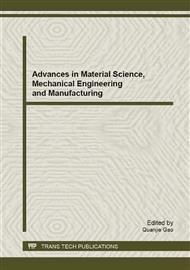[1]
B.T. Lebele-Alawa, H. Hart, S.O.T. Ogaji and S.D. Probert. Rotor-blades' profile influence on a gas-turbine's compressor effectiveness. Applied Energy, 2008, vol. 85, issue 6, pages 494-505.
DOI: 10.1016/j.apenergy.2007.12.001
Google Scholar
[2]
I.A. Hamakhan, T. Korakianitis. Aerodynamic performance effects of leading-edge geometry in gas-turbine blades. Applied Energy, 2010, vol. 87, issue 5, pages 1591–1601.
DOI: 10.1016/j.apenergy.2009.09.017
Google Scholar
[3]
Walraevens R E, Cumpsty N A. leading edge separation bubble on turbormachine blades. Journal of turbomachinery, 1995 vol. 117, pages 115-125.
DOI: 10.1115/1.2835626
Google Scholar
[4]
JIN Jun, LIU Bo, NAN Xiang-yi, CHEN Yun-yong. Influence effect of supersonic airfoil's leading edge geometric shape on aero-dynamical performance of cascade. Journal of AerospacePower, 2007, vol. 22, no. 4, pages 660-665.
Google Scholar
[5]
Chu, Lei-Zhe; Du, Jian-Yi. Effect of the blade leading edge on the performance of a centrifugal compressor. Journal of engineering thermophysics, 2008, vol. 29, no. 5, pages 767-769.
Google Scholar
[6]
Andrew W. Fitzgibbon, Maurizio Pilu, and Robert B. Fisher. Direct Least Squares Fitting of Ellipses. Pattern Analysis and Machine Intelligence, 1999, vol. 21, issue 5 , pages 476 – 480.
DOI: 10.1109/34.765658
Google Scholar
[7]
Radim Halir, Jan Flusser. Numerically stable direct least squares fitting of ellipses. The Sixth International Conference in Central Europe on Computer Graphics and Visualization, 1998, vol. 1, pages 125~132.
Google Scholar
[8]
F. Bookstein. Fitting conic sections to scattered data. Computer Graphics and Image Processing, 1979, vol. 9, issue 1, pages 56–71.
DOI: 10.1016/0146-664x(79)90082-0
Google Scholar
[9]
Gander, W., Golub, G. H. and Strebel R. Least-square fitting of circles and ellipses. BIT, 1994, vol. 43, pages 558–578.
DOI: 10.1007/bf01934268
Google Scholar
[10]
Anandaroop Ray, Deepak C. Srivastava. Non-linear least squares ellipse fitting using the genetic algorithm with applications to strain analysis. Journal of Structural Geology, Dec. 2008, vol. 30, issue 12, pages 1593–1602.
DOI: 10.1016/j.jsg.2008.09.003
Google Scholar
[11]
D K Prasad, M K H Leung, C Quek. An unconstrained, non-iterative, least squares based geometric Ellipse Fitting method. Pattern Recognition, 2012, vol. 46, pages 1449-1465.
DOI: 10.1016/j.patcog.2012.11.007
Google Scholar
[12]
Dale Umbach, Kerry N. Jones. A Few Methods for Fitting Circles to Data. IEEE Trans. Instrum. Meas., 2003, vol. 52, pages 1881–1885.
DOI: 10.1109/tim.2003.820472
Google Scholar
[13]
Maurice Clerc, James Kennedy. The Particle Swarm—Explosion, Stability, and Convergence in a Multidimensional Complex Space. Evolutionary Computation, 2002, vol. 6 , issue 1, pages 58 - 73.
DOI: 10.1109/4235.985692
Google Scholar
[14]
James Kennedy, Russell C. Eberhart. Particle swarm optimization. Neural Networks, 1995, vol. 4 pages 1942 - 1948.
Google Scholar


